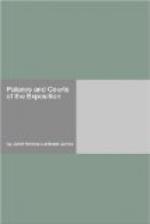The principal lighting is by great clerestory windows — great windows at the north and the south ends — also by skylights.
The building covers nine acres, and is the largest wooden structure in the world. It is about three blocks long.
The statues as well as the reliefs are by Haig Patigian of San Francisco.
Vigorous types like machinery itself are used.
The generation, transmission and application of power as applied to machinery are most interestingly represented.
The decorated drums of the columns show the Genii of Machinery.
The eyes of these figures are closed, reminding you that power comes from within.
Notice how from any point of view your figures suggest support at the sides of the drum.
The very position of the arms gives you a strong feeling of support.
The figures on the spandrels represent the application of power to machinery.
The figures on the pedestals represent:
1. “Steam Power” with the lever that starts the engine.
2. “Invention” showing a more intellectual type of face, carrying the figure with wings spread, suggesting the flight of thought. This thought, as it were, is above the world.
3. “Electricity” with foot on the earth, suggesting that electricity is not only in the earth, but around it. He carries his symbol, electricity.
4. “Imagination,” showing man with his eyes closed — seeing within. The bird of inspiration, the eagle, is about to take flight.
The wings on the head suggest the rapidity of thought or action.
Inside this great palace one sees the latest inventions in machinery. Ponderous machines capable of shaping tons of metal, great labor-saving machines, and all sorts of electrical appliances. “Safety first” is a pronounced feature of this exhibit.
Palace of Varied Industries
Architect — W. B. Faville of San Francisco.
The high walls, averaging seventy feet to the cornice, with their respective buttresses, are strongly suggestive of the California missions of the eighteenth century.
The “California bear” and the Seal of California are in decorative and suggestive evidence at the tops of the buttresses.
The green domes on the palace belong to the Byzantine school of architecture, such domes as one sees in the mosques of Constantinople and other Mohammedan centers.
The windows seen in the corner towers are the same kind that one sees used in the majority of mosques.
The beautiful central portal, facing south, is modeled after the Portal of the Hospice of Santa Cruz at Toledo, Spain.
It is 16th century Spanish Renaissance, known as the Plateresque style (from platero, silversmith).
The columns suggest a wood origin and look as if they had been turned in a lathe.




